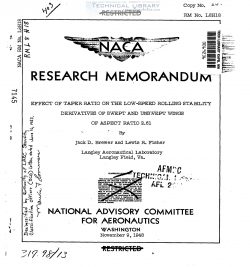naca-rm-l8h18
- Version
- 110 Downloads
- 584.85 KB File Size
- 1 File Count
- April 26, 2017 Create Date
- April 26, 2017 Last Updated
National Advisory Committee for Aeronautics, Research Memorandum - Effect of Taper Ratio on the Low Speed Rolling Stability Derivatives of Swept and Unswept Wings of Aspect Ratio 2.61

An investigtion has been condudted on a series of tapered swept
wings in the 6—foot circular test section of the Langley stability tunnel
under conditions simflating rolling flight.
The results of the tests showed. that a decrease in. taper ratio (ratio
of tip chord to root chord.) of a swept wing caused. a small decrease in
damping in roll at low and moderate lift coefficients; at high lift
coefficients, decreasing the taper ratio caused a large reduction in the
damping in roll, greatly reducing the increase obtained for the untapered
wing prior to maximum lift. For an unswept wing, 15. decrease in taper
ratio caused a moderate decrease in the damping in roll throughout the
lift-coefficient range. The rate of change with lift coefficient of the
yawing moment due to roll and of the lateral force due to roll were
slightly decreased by a decrease in taper ratio.
Available theory generally predicts the effect of change in. taper
ratio on. the rate of change of the yawing moment due to roll with lift
coefficient and on the damping in roll at zero lift more accurately than
it does the effect of sweep. Tip-suction effects, not accounted for by
the theory, my cause large errors in the theoretical values of the yaw-
ing moment due to roll and the lateral force due to roll. For a swept
wing the yawing moment due to roll can be estimated by applying a
correction to the available theory utilizing the experimental value of
the lateral force for an. unswept wing of the same aspect ratio and taper
ratio (the tip—suction force) and the geometric characteristics of the
wing.
An extensive investigation is being carried out at the Langley
stability tunnel to determine the effect of various geometric variables
on rotary and static stability characteristics. The values of the
stability derivatives are required for the determination of the dynamic
flight characteristics of an airplane. The static stability derivatives
are readily determined by conventional Wind-tunnel tests, and the rotary
stability derivatives, heretofore generally estimated from theory, can
now also be quickly determined. by the utilization of the stability—wind-
tunnel curved- and rolling-flow test equipment (references 1 and 2).
| File | Action |
|---|---|
| naca-rm-l8h18 Effect of Taper Ratio on the Low Speed Rolling Stability Derivatives of Swept and Unswept Wings of Aspect Ratio 2.61.pdf | Download |

Comment On This Post